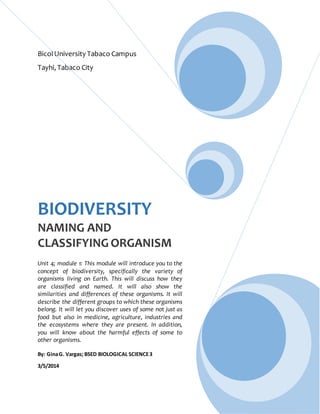
Lesson plan science
- 1. BicolUniversity Tabaco Campus Tayhi, Tabaco City BIODIVERSITY NAMING AND CLASSIFYING ORGANISM Unit 4; module 1: This module will introduce you to the concept of biodiversity, specifically the variety of organisms living on Earth. This will discuss how they are classified and named. It will also show the similarities and differences of these organisms. It will describe the different groups to which these organisms belong. It will let you discover uses of some not just as food but also in medicine, agriculture, industries and the ecosystems where they are present. In addition, you will know about the harmful effects of some to other organisms. By: GinaG. Vargas; BSED BIOLOGICAL SCIENCE3 3/5/2014
- 2. NAMING AND CLASSIFYING ORGANISMS I. OBJECTIVES At the end of the period, the student must be able to: 1. Understand the historical background of classifying organisms 2. Identify how organisms are being classified 3. Explain why organisms are needed to be classified II. SUBJECT MATTER Topic: Naming and Classifying Organisms Reference: module Materials: projector, laptop, papers Teachingstrategy: power point presentation, lecture discussion Skills: understanding, identifying, explaining III. LESSONPROPER PRELIMINARIES 1. Prayer, 2. Checking Of Attendance A. MOTIVATION Activity 1 What’sin a name? Objectives: After performing this activity, you should be able to: 1. give the names of organisms as they are known in your community 2. recognize the need to have a systemof classifying and naming organisms. Materials Needed: pictures of organisms pencil or ballpen sheet of paper Procedure: 1. Get pictures of organisms fromyour teacher.
- 3. 2. With your group, discuss how each of these organisms is called in your community. Accept any name which your groupmates will give for an organism. If you know othernames by which an organismis called in another place, include them. Write these on the sheet of paper. 3. Be ready when yourteacher asks you to present your work to the class. Take note of how the other groups named each of the organisms shown. Q1. Are there organisms that others gave the same name to as your group did? Give examples. Q2. Are there organisms that others gave a different name to as your group did? What are these organisms? Q3. What can you say about your knowledge of the organisms before the other groups’ presentations and the teacher’s discussion? B. LEARNING TASK INTRODUCTION OF THE TOPIC Species diversity consists of the large number and all different kinds, shapes, colors and sizes of organisms that inhabit the Earth. It includes the smallest and the simplest bacterium (pl. bacteria) to the complex, bigger, brightly colored flower or fish. Add to this the carabao, the tallest acacia, the biggest elephant and a human like you. These organisms are found in various places from the soil, to the rivers, oceans, and forests, salty or hot places, in short in every corner of the Earth. Some of them even live in your body. At present, more than a million organisms have been identified and named while many more are being discovered every year. Just recently, foreign and local researchers have found that diversity of reptiles And amphibians in the Northern Philippines is even greater than what has been known and identified. If there are a lot more of the organisms in the world than you can count, how will you be able to know about them? Does an organism you see in your place, for example, have the same name in another place? Do organisms have to be classified? Why? POWERPOINT PRESENTATION C:UsersWSCDocumentsZNEEHGeduc techPORTFOLIO-ET2LP'S-8- PPTSCIscience-PPT.pptx IV. EVALUATION
- 4. I. ENUMERATION 1.Give the 3 domain systemof classifying organism 2.Enumerate the 5 kingdomof classification of organisms 3.. Give at least five uses of protists. II. IDENTIFICATION 1. Where are sporesof yeasts produced? How are yeast spores called 2. Where are mushroomspores produced? 3. What is the advantage of the large numbers of spores produced by fungi? 4. Where in the Philippines would pine treeslikely grow? 5. In terms of leaf venation,is santan a dicot or a monocot? III. ESSAY 1. Describe cocci, bacilli,and spirilla. 2. Think of ways by which you can avoid leptospirosis? 3. Fromwhat you know and have observed about fungi, in what conditionsdo they grow? 4. How do liverworts, mosses and hornworts differin appearance? 5. Why do you think nonvascular plants cannot grow very large or tall? 6. How will Azolla help rice if they are grown together in fields? 7. Give other uses of ferns in yourlocality. 8. How would uncontrolled cutting of pine trees, for example, affect the forest ecosystem? 9. Describe how birds, butterflies and spiders benefit from members of the angiosperms. 10. What is the greatest contribution of plants to living things on Earth? 11. What harmcan weeds do to cropsif they grow together? 12. . In your observation, how are animalsdistinguished fromthe othergroups as to their reaction to stimuli? 13. Why do you think parasitic flatworms do not have a digestive system? 14. How would you describe univalves? bivalves? 15. How do arthropods differ fromechinoderms? V. ASSIGNMENT Make a tree diagram showing the different kingdom and species of organisms